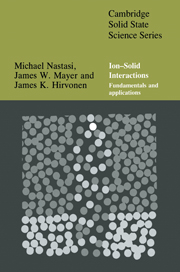Book contents
- Frontmatter
- Contents
- List of symbols
- Preface
- Chapter 1 General features and fundamental concepts
- Chapter 2 Interatomic potentials
- Chapter 3 Dynamics of binary elastic collisions
- Chapter 4 Cross-section
- Chapter 5 Ion stopping
- Chapter 6 Ion range and range distribution
- Chapter 7 Radiation damage and spikes
- Chapter 8 Ion–solid simulations and diffusion
- Chapter 9 Sputtering
- Chapter 10 Order–disorder and ion implantation metallurgy
- Chapter 11 Ion beam mixing
- Chapter 12 Phase transformations
- Chapter 13 Ion beam assisted deposition
- Chapter 14 Applications of ion beam processing techniques
- Chapter 15 Ion beam system features
- Appendix A Crystallography
- Appendix B Table of the elements
- Appendix C Density of states
- Appendix D Derivation of the Thomas–Fermi differential equation
- Appendix E Center-of-mass and laboratory scattering angles
- Appendix F Miedema's semi-empirical model for the enthalpy of formation in the liquid and solid states
- Appendix G Implantation metallurgy – study of equilibrium alloys
- Appendix H Physical constants, conversions and useful combinations
- Index
Chapter 13 - Ion beam assisted deposition
Published online by Cambridge University Press: 27 January 2010
- Frontmatter
- Contents
- List of symbols
- Preface
- Chapter 1 General features and fundamental concepts
- Chapter 2 Interatomic potentials
- Chapter 3 Dynamics of binary elastic collisions
- Chapter 4 Cross-section
- Chapter 5 Ion stopping
- Chapter 6 Ion range and range distribution
- Chapter 7 Radiation damage and spikes
- Chapter 8 Ion–solid simulations and diffusion
- Chapter 9 Sputtering
- Chapter 10 Order–disorder and ion implantation metallurgy
- Chapter 11 Ion beam mixing
- Chapter 12 Phase transformations
- Chapter 13 Ion beam assisted deposition
- Chapter 14 Applications of ion beam processing techniques
- Chapter 15 Ion beam system features
- Appendix A Crystallography
- Appendix B Table of the elements
- Appendix C Density of states
- Appendix D Derivation of the Thomas–Fermi differential equation
- Appendix E Center-of-mass and laboratory scattering angles
- Appendix F Miedema's semi-empirical model for the enthalpy of formation in the liquid and solid states
- Appendix G Implantation metallurgy – study of equilibrium alloys
- Appendix H Physical constants, conversions and useful combinations
- Index
Summary
Introduction
The bombardment of a growing film with energetic particles has been observed to change for the better a number of characteristics and properties, critical to the performance of thin films and coatings, such as adhesion, densification of films grown at low substrate temperatures, modification of residual stresses, control of texture (orientation), modification of grain size and morphology, modification of optical properties, and modification of hardness and ductility.
The process of simultaneous thin-film deposition and directed ion bombardment from an ion source has been labeled by a variety of terms including: ion assisted coating (IAC); ion assisted deposition (IAD); ion vapor deposition (IVD); ion beam enhanced deposition (IBED); dynamic recoil mixing (DRM) at high energies; and ion beam assisted deposition (IBAD). This term, ion beam assisted deposition, or IBAD, will be used here in favor of its growing acceptance by the energetic-particle–solid interaction research community.
The important role of ions in thin-film deposition techniques has long been realized by the coating community. It is difficult, however, in many of the plasma based coating techniques, to separate out the degree to which ion and neutral particle fluxes as well as ion energies affect resultant coating properties. Mattox (1982) showed as early as 1963 that energetic ions within plamsa had an important influence on coating properties in his early development of ion plating. In addition, other plasma-based deposition processes, such as activated reactive evaporation (ARE), developed by R. F. Bunshah and co-workers (Bunshah, 1982), employ ionization to promote film properties.
- Type
- Chapter
- Information
- Ion-Solid InteractionsFundamentals and Applications, pp. 363 - 407Publisher: Cambridge University PressPrint publication year: 1996
- 1
- Cited by



